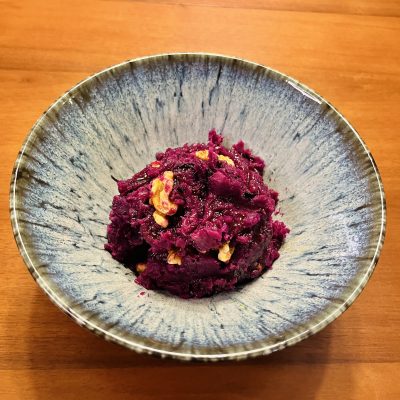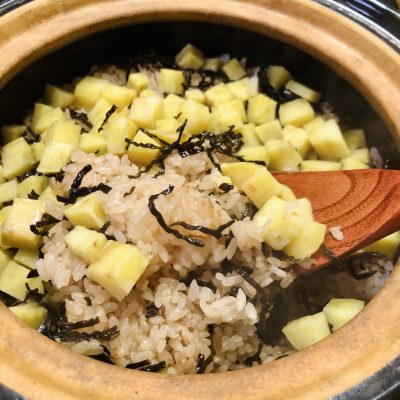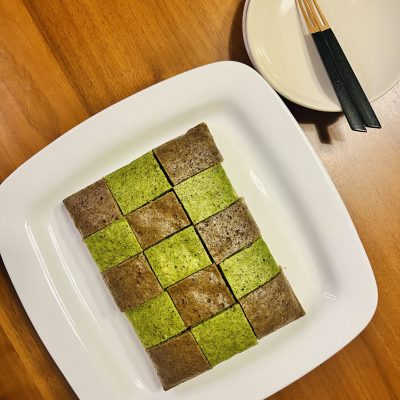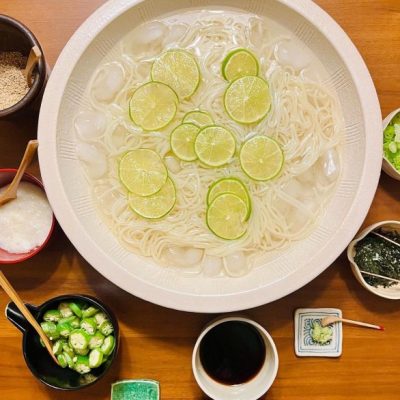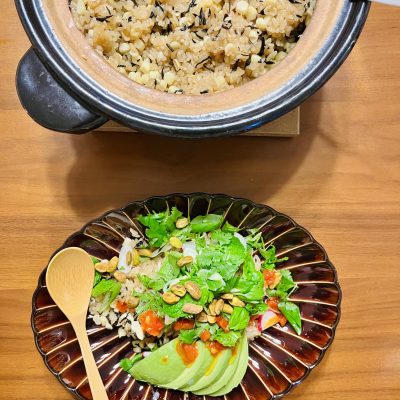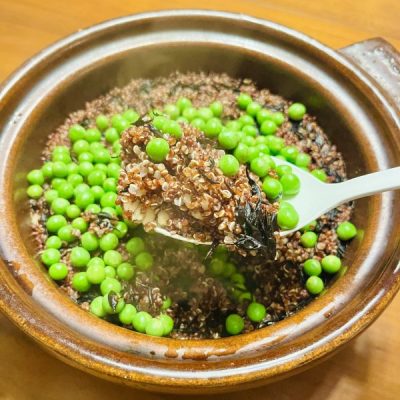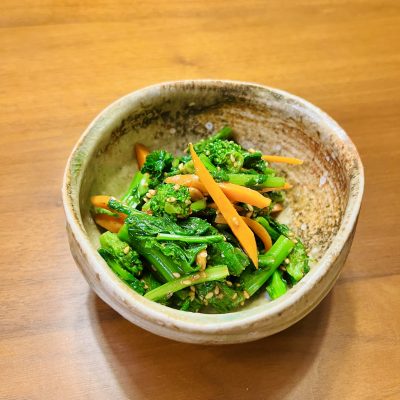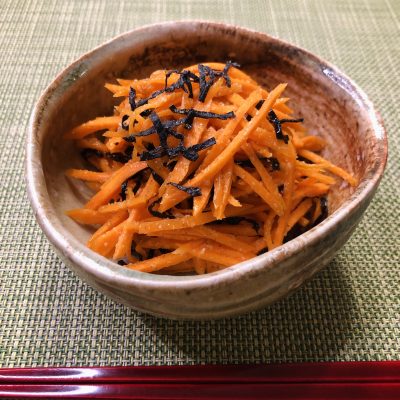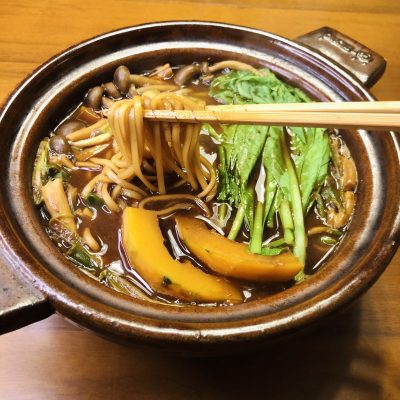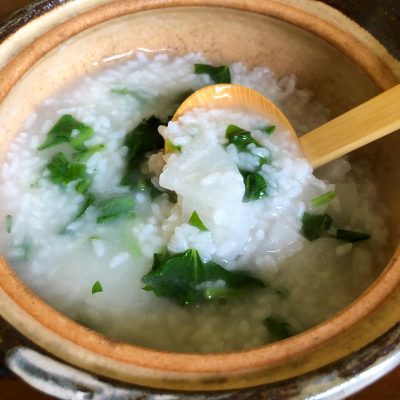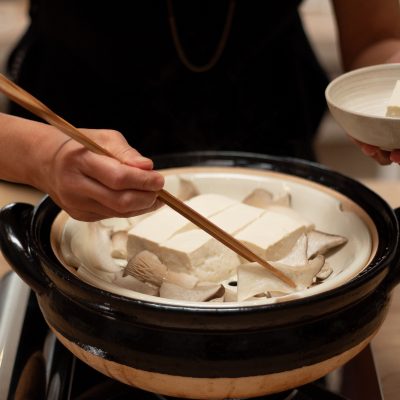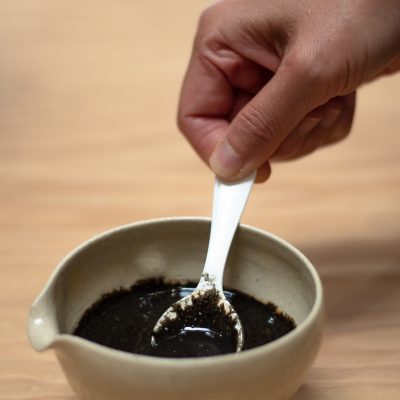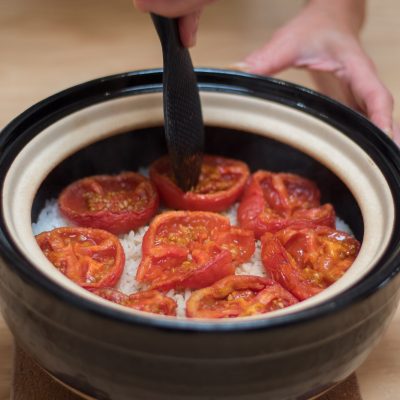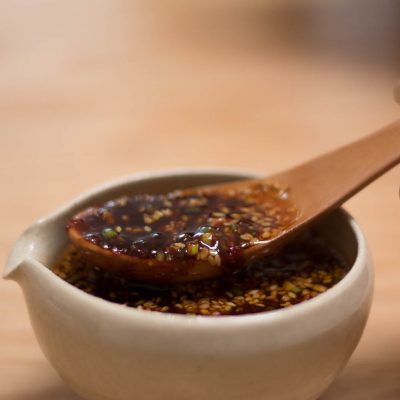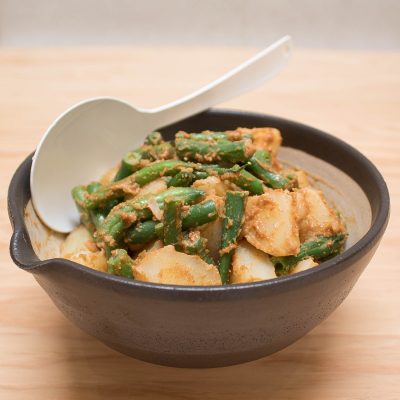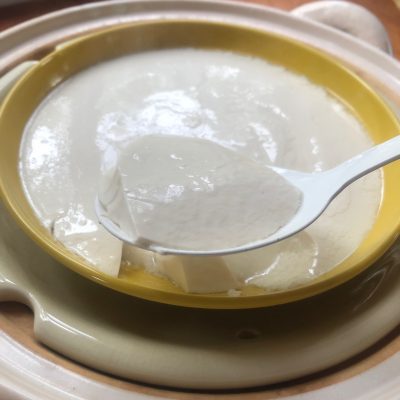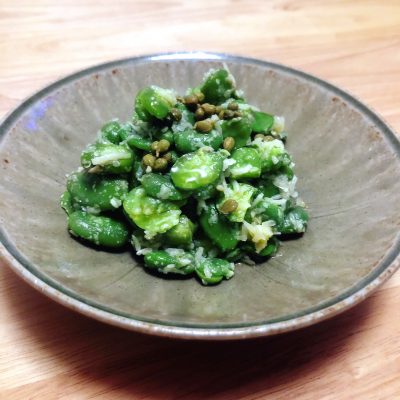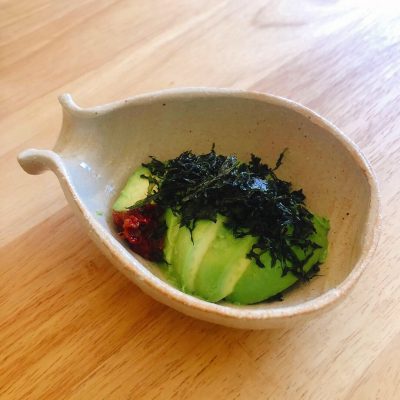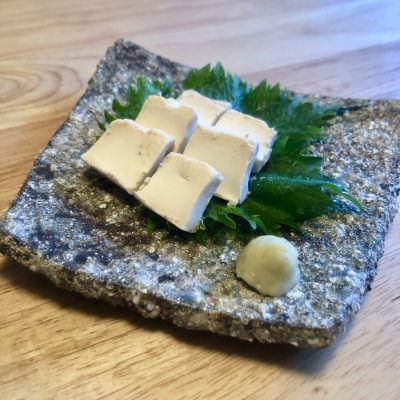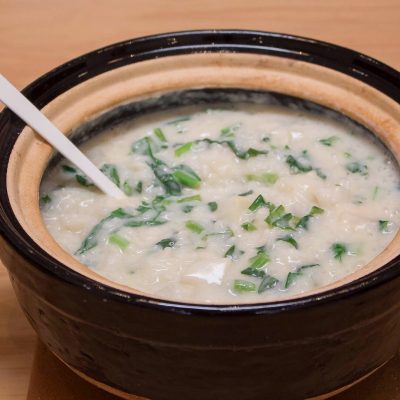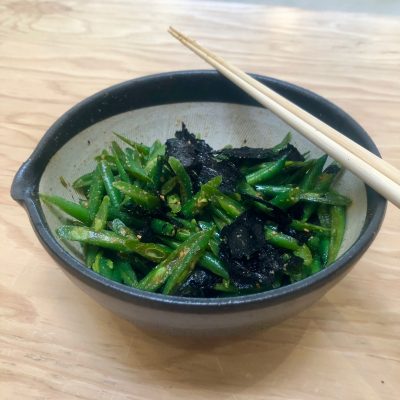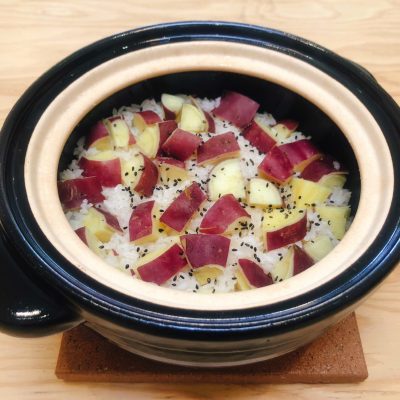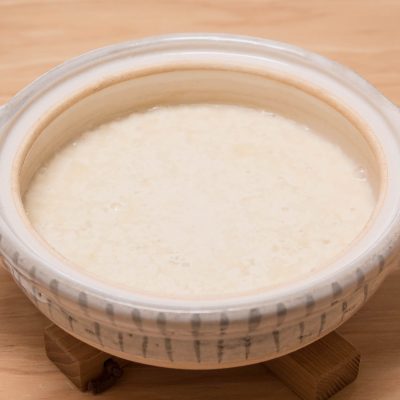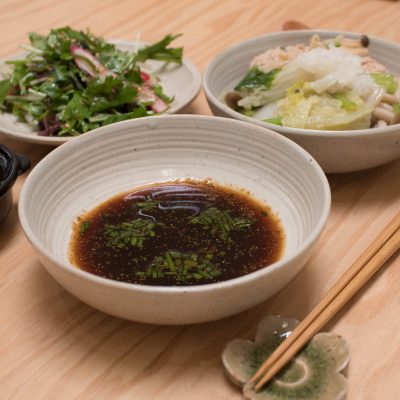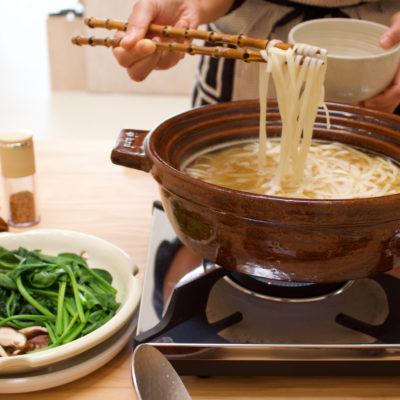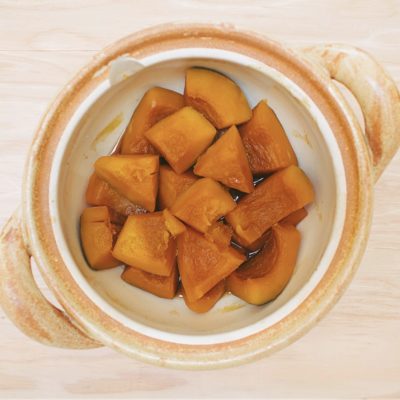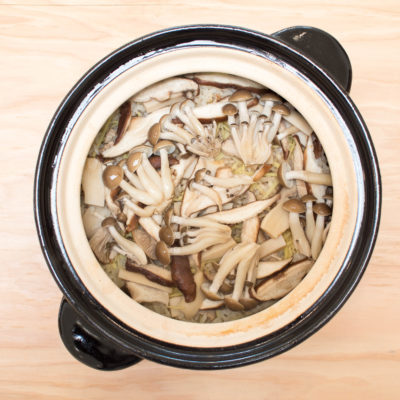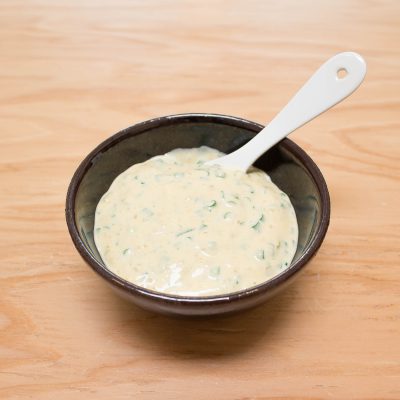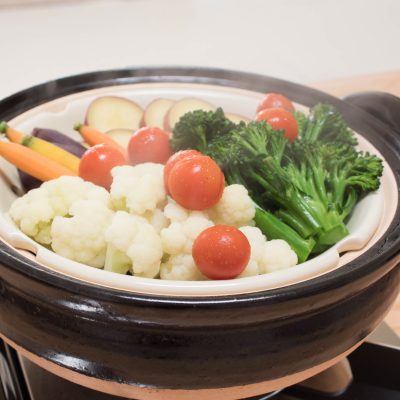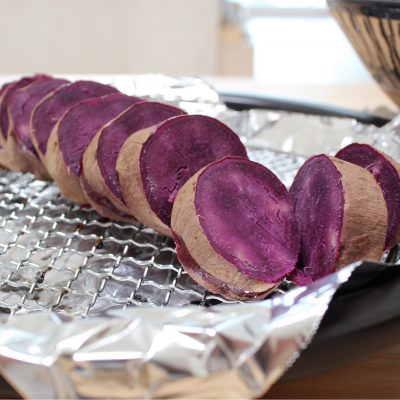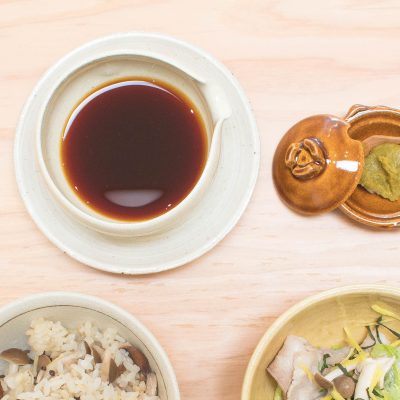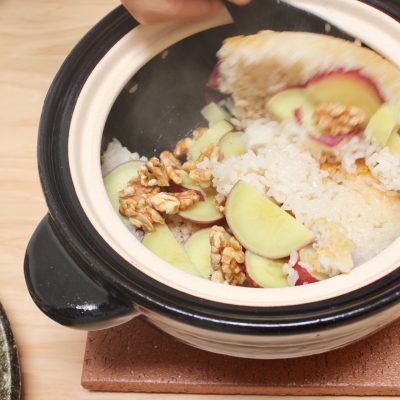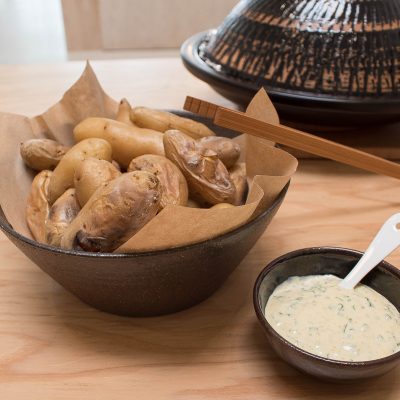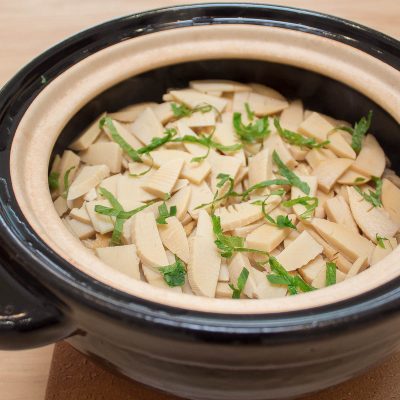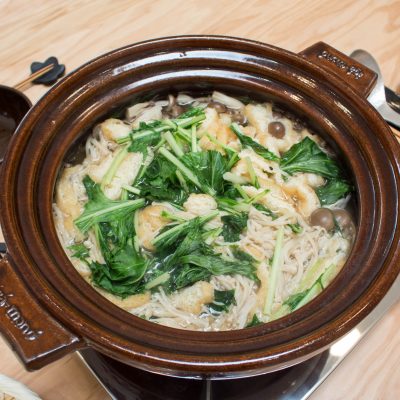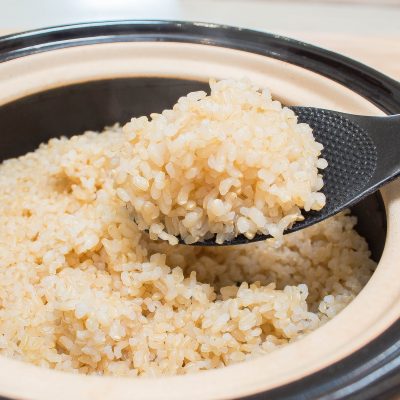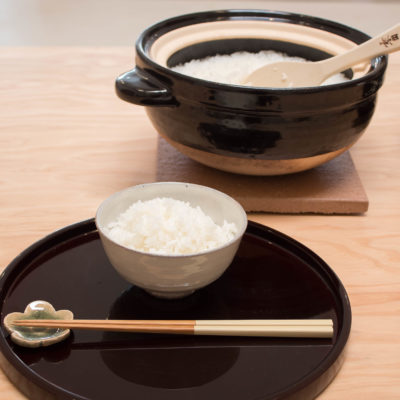My summer obsession of donabe corn rice has so many variations and this one is my new favorite! I never thought the combination of umeboshi (Japanese pickled plum) and corn make such great combination in flavors. I love making onigiri with this rice to take to picnic!
Tag Archives: Vegetarian
Yuba & Daikon Mille Feuille Nabe
Made with napa cabbage, yuba (tofu skin) and daikon, this new Mille Feuille Nabe is completely plant based, and no flavor is compromised compared to the other meat versions I have introduced. It’s rather, the flavor is so rich and the combination of yuba and miso broth brings heartiness. I can enjoy this dish all year round and my body feels so nourished!
I found delicious soft yuba by Hodo at a local Whole Foods. Yuba is not only nutritious dense, but it as the great texture and flavor. So, hope you can find it near you.
English Peas & Hijiki Mochi Mugi Rice
I can’t get enough of fresh English peas in the spring time. Here’s a slightly different version (and I would say even easier version) of my original English Peas and Hijiki Rice recipe, and this is equally delicious! Instead of using dashi stock, I add a content of a Vegetable Dashi packet directly to the water. The result is really umami rich and aromatic rice. Mochi Mugi barley adds nice texture and flavor, too. If you can’t find shelled fresh English peas, you can use frozen kind by thawing them before adding to the donabe.
Roasted Purple Sweet Potato and Shio-Kombu Salad
Can’t get enough of donabe roasted purple sweet potatoes! Here’s an ultimate “non-recipe” recipe I make all the time. Super simple and super tasty always. The sweet potato becomes so rich in flavor and creamy texture when roasted in Roast Donabe, and this magical condiment, Shio-Kombu (salt seasoned shredded kelp) totally complements the flavors along with evoo and roasted walnuts. You really don’t need anything else!
Shio-Kombu & Sweet Potato Rice
Shio-kombu is one of the staple items in my pantry. It’s shredded seasoned kombu (kelp), and I like to toss them in a simple salad or use as a topping over rice, tofu, add to stir-fry, etc. It’s so versatile. My Ginger Shio-Kombu Rice recipe in the DONABE Cookbook is one of the most popular recipes among the donabe fans.
Here’s another donabe rice dish using shio-kombu. It’s Shio-Kombu & Satsuma-Imo Gohan. It’s a simple and delicious donabe rice, cooked with shio-kombu and Japanese sweet potato. As a “guilty pleasure”, after scooping the rice into a bowl, I like to top it with a small slice of butter (this time, I used this special cultured seaweed butter from France) Super good.
Spinach and Daikon Porridge
This is quick Spinach & Daikon Porridge I have been making often lately. It requires minimum prepping/ chopping. Instead of starting with cold water and rice, I boil vegetable dashi and add rice to cook. The texture of the rice turns smoother this way, and the flavor is amazing. The combination of daikon and spinach makes the dish taste even better.
Eggplant & Shiitake Linguine
This donabe dish is something I can whip up with ingredients I can usually find in my kitchen on a regular night. Eggplant and shiitake mushrooms are simply cooked in a donabe and finished with canned cherry tomatoes (you can use regular canned tomato or tomato purée). It’s rich in umami as I use sake and shio-koji for seasoning for a little Japanese kick, but you can do without also. I love to use my Roast Donabe, which is dry-heating capable and also equipped with extra-thick body and sturdy flat lid. With these features, this donabe promotes extra pressure and steaming effect and the ingredients can cook faster and very effectively with minimum liquid. This is a hearty and delicious vegan dish if you go without cheese (or use vegan cheese). I love adding the Parmigiano Reggiano at the end!
Steamed Houjicha and Matcha Olive Oil Cakes
I love and love donabe steam tea cakes! And both Houjicha and Matcha flavors are my top favorites. The rectangular mold with a removable tray is also a must-have item for me, and I make so many things with this mold. Here, I wrote down Houjicha Olive Oil Steam Cake recipe. For the Matcha version, you can simply substitute the houjicha with 1 tablespoon of matcha powder and reduce the hot water to 2 tablespoons. For these, I used extra virgin olive oil and almond milk, so the recipe is dairy free and it’s so light and fluffy! Happy Donabe Life!
Cold Somen Noodle with Soy Dipping Sauce
Perfect for a hot summer day. Here’s one of my most basic cold noodle dishes which I never get tired of all my life. Donabe can make a perfect serving vessel, and it also makes a wonderful presentation, along with a variety of toppings.
For the dipping sauce, I have this staple soy-based sauce, Kaeshi, always in handy. Kaeshi is a multi-purpose sauce I use for so many things. I pour over noodle by mixing with water/ dashi, chicken, fish, salad, etc.
Corn & Hijiki Rice with Olive Oil
This donabe dish is a variation of my other corn rice recipes and has been a big hit! This is 100% vegan and its flavor is really rich with corn, and fresh and aromatic with the addition of the extra virgin olive oil and mixed herbs. This dish makes a great one plate meal and tastes great at a warm or room temperature. Happy Donabe Life!
3-3-3 Corn Salad
Only 3 ingredients, 3 minutes steaming, and 3 steps – this simple “no-recipe” recipe showcases how our donabe steamer, Mushi Nabe can quickly cook the corn and brings out its natural sweetness while retaining its crispness. You can embellish the dish with additional ingredients if you like, but I really love this simplicity and savor the beautiful flavor combo of sweet corn, Yuzu Salt, and olive oil. Perfect appetizer/ side dish for your summer BBQ dinner!
Tofu Shakshuka
Shakshuka, a popular mediterranean dish of baked egg and tomatoes have been one of my favorite breakfast dishes when I go out past years, and at home, I have been enjoying making different versions myself. First of all, my donabe can make the simple and delicious one-pot Shakshuka! Now, my go-to shakshuka is made with tofu, mushrooms, and cherry tomato sauce. You can enjoy with crusty bread, or pour it over roasted sweet potatoes like I usually do. I like to make a large batch to share out of a donabe , or you can transfer to small-size donabe (such as Izakaya Nabe or small Donabe Casserole) to make individual size.
English Peas and Hijiki Quinoa
This is a variation of my donabe rice recipe, English Peas and Hijiki Rice. Instead of rice, I am useing quinoa and mochi mugi barley and cook in vegetable stock in a donabe .To finish, I season simply with salt and pepper, and drizzle good amount of extra virgin olive oil! Feel free to elevate the dish with addition of different herbs or seasonings, if you like. You can serve it on its own or this can also makes a wonderful side dish served with grilled fish, vegetables, etc. I used Bistro Donabe for this dish, but any donabe with enough depth can work for this recipe. Happy Donabe Life!
Egg Porridge
This donabe egg porridge is an extremely simple dish and made with just three ingredients – water, rice, and egg. This is one of my favorite dishes since I was a child. When I got sick, this is what my mom used to make for me, and I always looked forward to a small donabe brought to my bed and mom serving it for me! Egg porridge is so gentle on stomach and easy to digest. It is a perfect dish to enjoy a day after a big holiday meal. I like to serve it with a couple of condiments- Yuzu Salt and nori furikake called Nori Senbyo. Or with just a little sprinkle of Moshio sea salt is lovely, too.
Rapini in Sesame Karashi Sauce
Rapini (broccoli rabe) has a nice light bitter flavor and makes a good combination with the hot kick of karashi (Japanese mustard). I also add some sesame paste and it tastes really wonderful. This can be served either cold or cool and makes a nice appetizer or a side dish. The sauce is quite versatile, so you can enjoy it with different kinds of vegetables such as broccoli, cauliflower, green beans, etc.
Shio-Kombu Carrot
I love Shio-Kombu (salt-seasoned kelp) so much and always keep it in my pantry. I mix it with rice, salad, add to hot pot, etc. Shio-Kombu is so versatile!
This quick Shio-Kombu Carrot has great flavor and texture, and I can easily eat a whole large carrot myself this way. In order to release excess moisture of the raw carrot, sliced carrots are lightly seasoned and left with a weight for about 15 minutes or so. I used Jukusei Meijin (small fermentation jar), but you can also use the Glass Pickle Maker or just a small bowl with a weight.
Hatcho Miso Udon Hot Pot
This dish can be made so quickly and create a balanced one-pot meal. I love the deep flavor of hatcho miso which is a dark miso. The flavor is almost chocolaty. Once the udon noodles are par-cooked, all the ingredients are cooked in one donabe. I like vegetables and tofu in this dish, so this dish is completely vegan. But, if you like, you can also enjoy this dish with an addition of meat. Chicken or duck slices are particularly good.
Roasted Sweet Potato
My favorite way of eating Satsuma-imo (Japanese sweet potato) is a simple yaki-imo (roasted sweet potato). When I was a child, there were many Yaki-imo trucks which drive around the neighborhood to sell piping hot yaki-imo out of the stone roaster in the back of the truck. It’s no longer a common site in Japan, but you can still spot these driving vendors in the winter time.
I find Roast Donabe is the best tool for roasting sweet potatoes. I’m obsessed with this! Its extra-thick body and sturdy flat lid effectively seal the moisture inside while intensely cooking the ingredients to the core, and takes the roasted sweet potato to a whole new level. The potato becomes nicely caramelized and skin comes right off. I like to put a little butter to enjoy this, but this tastes so good without anything.
You can also make roasted potatoes with Ibushi Gin or Fukkura-san (cooking time may vary).
Daikon Porridge
Steamed Tofu & Mushrooms with Black Sesame Sauce
It feels like I have been making this dish all the time. It’s something I can make without even thinking and love it every time. Yes, it’s really the simplest dish you can think of. Just steamed tofu and mushrooms in a donabe steamer, Mushi Nabe. At the same time, this dish really showcases how a simple ingredients can taste so good when cooked in Mushi Nabe and makes me re-appreciate the beauty of minimalism.
I like to serve it with my Black Sesame Sauce, but they can obviously go well with many other types of sauce/ condiments, including ponzu, sea salt & sesame oil, etc.
Black Sesame Sauce
This is a very healthy and tasty all-purpose sauce, and made with all “black” ingredients. All you need to do is just whisk together black sesame paste, black sesame seeds, black vinegar, soy sauce, and black sugar. My regular way to use this sauce is to serve with simple steamed tofu and mushrooms. You can also enjoy it with steamed vegetables, fish, etc.
Smokey Shoyu Corn Hijiki Rice
This rice dish has been a big hit throughout this summer, and I made it many times. As long as you have nice sweet fresh corn, this dish can almost never fail. Corn and hijiki seaweed go so well together (I also like to make a salad dish featuring these two ingredients), and they blend in with the rice nicely.
The butter and Smoked Soy Sauce are added after the rice is made, so they keep the really fresh flavors. The aroma is quite irresistible. If you don’t have the Smoked Soy Sauce, you can use a regular soy sauce for a non-smokey version.
Matcha Almond Milk Kudzu Jelly
This is one of my favorite cold desserts. It’s very simple to make and the flavor is so rich and elegant. The key is a high quality matcha and kudzu powder (plant based starch – the kind I use is considered to be among the top quality kind from Yoshino region of Nara, Japan). The texture is nicely bouncy and the flavor is so rich, although there is no butter or cream used. In fact, it’s completely vegan. Kuzu mochi is a traditional Japanese dessert, made of simply kudzu powder and water. And, this is my variation which has matcha and almond milk. You can make it one day in advance, so this makes a nice dessert when you have a dinner party.
Slow-Roasted Tomato Rice
Tomato is one of my favorite summer vegetables (or technically it’s a fruit), and make a lot of slow-roasted tomatoes for various recipes. One of them is Cold Somen Noodles with Slow-Roasted Tomato, and here is another one! Once you have the slow-roasted tomatoes ready, all you need to do is basically make plain rice with Kamado-san, then top the rice with the slow-roasted tomatoes. You can gently break the tomatoes to mix with the rice. The umami of the tomatoes are so condensed after the long slow roasting, the rice itself doesn’t need any other flavoring or seasoning.
I love it with chopped Japanese herbs and chunky la-yu (recipe is found in my DONABE Cookbook), but commercial la-yu (spicy chili oil) or any hot sauce can work, too.
Nao-Jan (Naoko’s Yakiniku Sauce)
This is my regular tare (dipping sauce) for yakiniku (grilled meat), or anything grilled including seafood and vegetables. It’s rich in flavors with two kinds of soy sauce (or you can make with one kind), Hatcho miso, ginger, garlic, etc. And the addition of the pure daidai citrus juice gives the beautiful aromatic nuance. Great accompaniment for anything I cook with my Iga-yaki grills.
Steamed Green Beans and Potatoes in Sesame Peanut Butter Sauce
This simple steamed dish is always a big hit when I serve to my guests, and everybody loves watching the process of making it, too. When the potatoes and green beans are steamed in donabe, they tend to retain both the nutrients and texture, while the flavor becomes so rich and pure. To make the sauce, the sesame seeds are first roasted in horoku (sesame roster) until fragrant, then they are ground in suribachi and surikogi (Japanese mortar and pestle) and mixed with seasonings. The steamed vegetables are added directly to the sauce in the suribachi and tossed together. And, you can serve it right out of it at the table. Sesame and peanut butter add nice richness to the dish. For the sauce, I normally add leftover dashi (either kombu & shiitake mushroom dashi or kombu & bonito dashi) for extra subtle layer of flavors, but you can totally go with just water, if you don’t have dashi and it would still taste delicious.
Homemade Silky Tofu
Steamed Fava Bean Salad with Sansho
Fava beans are among my favorite spring ingredients, and I get so excited when I see them at a local farmers market. When they are in season, they are so flavorful that I like to prepare them in simple ways. Here is one of my quick and frequently-made fava bean recipes. I steam the shelled fava beans for a few minutes, peel them and toss them with extra virgin olive oil, grated Parmigiano Reggiano, and top with some Salt-Pickled Sansho Berries. The dish is amazing. If you don’t have sansho berries, you can simply finish with sansho powder (and adjust the seasoning by adding a little amount of sea salt).
Avocado Sashimi
It takes no time to prepare this dish, and this appetizer is quite addictive. Just slice up a ripe avocado, drizzle high quality extra virgin olive oil, and serve with Kanzuri paste and Coarse Nori Crumbles from Ariake Sea. The nori crumbles give such a nice sweet ocean aroma and delicate crunch, but high quality sheet nori can work also, by coarsely breaking it by hand. With this dish and a nice sake, I’m just happy.
Miso-Marinated Cream Cheese
Super easy to make with just a few ingredients, with just a little bit of patience, this dish makes a great snack/ appetizer to easily please your guests. All you need to do is to marinade a block of cream cheese in miso+mirin mixture for a few days or longer. This is also a perfect dish to keep stock in your fridge, so you can just slice and serve when you want to quickly entertain your guest or when you need one more little dish. You can enjoy the slices with a little wasabi on the side to enjoy with your sake. Or, this can make wonderful canapés to serve on crackers at a party. And, that’s what we did at a event at TOIRO the other day…it was a big hit!
Curry & Tamari Flavored Steam-Fry Vegetable Yakisoba Noodle
Enjoy this one-pot dish made with fresh yakisoba noodles and a lot of vegetables. I’ve been making this dish for years and had so many people turned on to this dish. The curry and tamari soy sauce flavors make a great combination. The noodles become nicely spicy and robust. This is a completely vegan dish with layers of flavors and textures. The sauce and sun-dried tomatoes bring out the rich umami, too.
Soymilk Porridge with Turnips
I eat a lot of porridge especially in the winter time, as the dish is not only so gentle to your stomach, but is also a great way to keep your body warm. In Japanese tradition, on January 7, we eat Nanakusa-gayu (7-herb rice porridge), and it’s a custom to to bring health and longevity. It also has a meaning to clean your body with this simple porridge after consecutive days of feast during the New Year holidays.
Outside of Japan, including Los Angeles where I live, it’s not easy to source all the 7 kinds of Japanese herbs locally, so I actually enjoy making my own version with just kabu (Japanese turnips; its’ leaves are one of 7 herbs in Nanakusa-gayu) and use pure soymilk, in addition to kombu infused water, to cook the rice. It’s rich, creamy, really flavorful, and still light in your stomach.
It’s totally fine to cook it only with water (for more plain version), or use your choice of dashi such as kombu and bonito dashi for slightly deeper flavor. And, you can enjoy with your choice of condiments.
Green Beans and Nori Salad
This quick salad dish is very easy to make, and I love how the nori brings a beautiful aroma to this dish. The roasted and ground sesame seeds, yuzu juice, and sesame oil adds extra layers of flavor, and go well with the tender green beans steamed in Mushi Nabe. You can substitute the golden sesame seeds/ golden sesame oil with black sesame seeds/ black sesame oil for a variation. The tamari soy sauce not only gives the rich umami to the dish, but makes the dish friendly for those on a gluten-free diet.
Japanese Sweet Potato Rice
This is one of my favorite fall-to-winter rice dishes since I was a child. This is such a simple dish, as the main ingredients are just the rice and satsuma-imo (Japanese sweet potato), and they are seasoned very lightly only with salt. The natural sweetness of the satsuma-imo is fully brought out after cooked with the rice, and the texture is nicely soft to work great with the shiny chewy rice. I also love making onigiri (rice balls) with this dish. They taste great hot or room temperature. If you want to add more flavor, you can cook the rice with dashi or even consommé works nicely, too.
Homemade Tofu
Authentic fresh tofu can be made at home very easily, once you have a donabe and high quality soymilk. All you need to do is to heat soymilk, stir in nigari liquid, turn off the heat, and rest until the mixture sets to become tofu. Iga-yaki donabe is perfect for fresh tofu making, because the porous body achieves the gentle and even heat distribution. It also cools down very slowly after turning off the heat, so the tofu can set to ideal stage during the resting time. The fresh warm tofu right out of donabe is simply a joy and I always have my first few tastes without any seasonings or condiments. It’s so fluffy, delicate, and pure. Then, I enjoy it with different toppings. Sometimes simply with shaved katsuobushi (shaved dried bonito flakes) and soy sauce, or wasabi, sea salt (such as moshio sea salt), and sesame oil. Ponzu is great, too.
Premium quality Banrai Soymilk and Banrai Nigari Liquid are both available at our shop. So, hope you give it a try. You can make a full-size sukui tofu to share or a small individual-size tofu in a mini-size donabe for everyday breakfast.
The recipe introduced in this page is calling for 1-liter soymilk. For the half amount, you can use a small-size classic-style donabe (approx. 0.8-qt/ 800 ml size). The photos below are made with small-size Rikyu-Tokusa donabe.
For an idividual-size silky tofu making method, please see Banrai Soymilk and Banrai Nigari Liquid product page.
Sansho Ponzu Sauce
Combination of soy sauce, daidai citrus and sansho powder (did you know sansho also belongs to citrus family?) create such refreshing bright aroma and kick in this quick dipping sauce. Adjust the amount of sansho powder according to your taste (or tolerance to its numbing heat). Originally introduced to serve with Shiso Chicken Meatball and Grated Daikon Hot Pot, this sauce is good for any hot pot dishes, or as a dipping sauce for gyoza dumplings.
Earthy Burdock Root Rice
Gobo (burdock) has a natural sweet earthy aroma, and I love the combination of minced gobo with rice for its hearty taste. Daikon leaves add a layer of earthy flavors and texture. If you can’t find daikon leaves, kale can work nicely, too. With this rice dish and a bowl of miso soup, it will make a happy donabe meal for me.
Soup Udon with Steamed Vegetables
This vegan treat is so easy to make and very satisfying. You just prepare the dashi broth for the udon in the bottom bowl of the Mushi Nabe, set the steam grate on top to steam the vegetables first. Once the vegetables are ready, remove the grate and cook the udon in the broth. Because the vegetables are steamed, they tend to retain more nutrients and taste very pure. The ginger-scented broth stays also very clear and the flavor is so rich in kombu‘s umami. So, this is a win win dish. In this recipe, I used Bistro Mushi Nabe, but you can make this dish with any donabe which is equipped with a steam grate. Adjust the recipe amount according to your size of donabe.
Japanese-style Simmered Kabocha
This is a classic Japanese home-style dish, and we love the full flavor of nutty kabocha with light seasoning of soy sauce, etc. This dish is almost ridiculously easy to make. Once you arrange the cut kabocha pieces with seasonings in a donabe, you heat it and let the donabe do the work for you. You don’t even need to stir the contents. With Miso-shiru Nabe, the delicate kabocha can cook so tender without falling apart.
Tofu & Spinach Hot Pot
Yu-Dofu (tofu hot pot) is a very simple and popular home dish in Japan. This version has addition of spinach and enoki mushrooms to boost nutrients and flavors. Yu-Dofu‘s best accompaniment is ponzu, and my quick daidai citrus ponzu tastes so refreshing and aromatic. Then, you can top the tofu with a generous amount of freshly-ground toasted sesame seeds in suribachi and surikogi (Japanese mortar and pestle), which is so nutty and aromatic. Kanzuri (chili condiment from Niigata, Japan) is another great condiment.
Mixed Mushroom Rice
I love the earthy treat. I like to use a few kinds of mushrooms such as shiitake, king oyster, and shimeji. You can try with your choice of mushrooms. By adding sweet rice, the dish becomes nice and slightly chewy texture, but you can also make it only with short grain rice and it will taste very nice, too. For seasoning, I love white tamari, for its mellow and slightly sweet aroma, but you can substitute with usukuchi shoyu or regular soy sauce, too.
Tomato Ginger Rice
Half-cut tomatoes are cooked together with rice in the donabe and becomes an extremely luscious dish. Tomatoes break so easily with a rice paddle and once you gently mix the contents, the beautiful red color coats the rice and imparts the sweet aroma of tomatoes and ginger. While this dish is completely vegan, even my meat-loving friends go crazy over it. (And, they fight over Naosco, the Yuzu-Kosho flavored hot sauce I make as a condiment for this dish.)
I love making this dish while the tomatoes are in season during summer. But, tomatoes don’t have to be very ripe to make this dish, so you can enjoy making this dish any time of the year.
Yuzu-Kosho Mayo Dipping Sauce
Made from Japanese mayonnaise, Yuzu juice, Yuzu-Kosho, and chives, this is a super quick dipping sauce which can be made with everything I always have in my fridge, and it always tastes so good. You can adjust the amount of the yuzu-kosho according to your taste. This sauce is great with Salt-Roasted Fingerling Potatoes made in Fukkura-san, or grilled vegetables, fish, etc.
Steamed Vegetables (Basic Steaming)
When I first tried simple vegetables steamed in Mushi Nabe, I was so surprised how pure and delicious they tasted. Mushi Nabe cooks vegetables fast and really brings out their natural flavors well. All I need to do is just get the seasonal high quality vegetables I like and steam in Mushi Nabe. Try those vegetable simply with a quick dipping sauce of some sea salt and extra virgin olive oil, or your choice of dipping sauce.
Steam-roasted Purple Sweet Potatoes
Simplicity at its best, when a sweet potato is steam-roasted in Fukkura-san, the texture becomes rich and creamy, and the flavor becomes so sweet. The glaze in the lid gives the effective FIR (Far-Infrared Rays…same effect as how a glowing charcoal heats to the core of ingredients) and moisture from the lid gives the perfect steam effect. I used purple sweet potatoes in this recipe, but you can use Satsuma-Imo (Japanese sweet potato with pale color interior) or other types of sweet potatoes or yams. Serve with simple sea salt & butter, or Shio-koji Mascarpone Dipping Sauce, suggested in this recipe below.
Shio-Koji Mascarpone Dipping Sauce
This simple combination of Liquid Shio-Koji and mascarpone cheese has the wonderful subtle sweet umami flavor from the shio-koji and rich creamy touch of the mascarpone. The sauce is great with Roasted Sweet Potato or as a topping for roasted vegetables such as beets and carrots.
Sansho Mayo
Just mix mayonnaise and some sansho powder, and all-purpose condiment is ready in a few seconds. Sansho adds the beautiful aromatic touch with tong-numbing spicy kick in the finish. Adjust the amount of sansho according to your taste. This condiment is great with smoked dish, fried chicken, fresh vegetable sticks, and so many more.
Quick Daidai Citrus Ponzu
This is a super simple ponzu, made by equal amount of Japanese daidai citrus (aromatic citrus, which is a type of orange) juice and high quality soy sauce. Great with tofu, grilled fish, etc.
Mochi Mugi Barley & Rice
Mochi Mugi is a type of barley and it is considered to be a “super food”, as it contains much higher amount of fiber than brown rice or regular kinds of barley. For me, Mochi Mugi simply tastes so good and I really enjoy its nice bouncy texture. By adding a small amount of Mochi Mugi to your rice, your rice becomes not only more nutritious but it adds another nice dimension in the flavor. For each packet of Mochi Mugi, 1/2 cup (120 ml) water is needed to cook.
Sweet Potato & Walnut Rice
Satsuma-imo (Japanese sweet potato) and roasted walnuts bring rich earth and sweet flavors to this dish.
Salt Roasted Fingerling Potatoes
Simplicity at its best, these salt-roasted fingerling potatoes always make my guests go crazy whenever I serve them at a dinner party. The potatoes are lightly salted and cooked in Fukkura-san over medium-high heat until done. It gives both the roasting and steaming effects during the cooking, and the result is always the best roasted potatoes I’ve ever tasted! The skin gets delicately crispy and the interior becomes almost creamy. Just be careful with the heat, as the donabe gets extremely hot during cooking and even for a while after the heat is turned off. I love to serve it with simple Yuzu-Kosho Mayo Dipping Sauce which I can whip up in seconds.
Bamboo Shoot Rice
Spring is the high season for freshly foraged bamboo shoots and they taste really wonderful. They are crisp tender and full of sweet spring flavors. In Japan, people enjoy so many different kinds of bamboo dishes while the fresh shoots are in season. Bamboo shoot rice used to be my favorite bamboo dish my mom made when I was a child. This dish also tastes great at room temperature or even cold. If fresh bamboo shoots are not available, pre-cooked bamboo shoot can be found at Japanese grocery stores and they are sold all year round.
Egg-topped Garlic Chives & Shiitake
Nira (garlic chives) and shiitake mushrooms are quickly simmered in kombu & shiitake dashi-based broth, then finished with eggs. I like the very soft and slightly runny stage of the eggs, so let it cook for a short time once the eggs are added. This dish is great as an appetizer (served as a soup), side dish, or I also like to pour over rice. If you can’t find nira, you can substitute it with spinach or pea shoot. You can also add rehydrated dry shiitake used to make the dashi for extra flavor and texture.
Mushroom & Mizuna Hot Pot
This simple vegan hot pot is so rich in flavor and satisfying. I like to slice the abura-age very thin, as these slices soak up the broth and taste like juicy noodles. If you don’t have access to abura-age, thinly-sliced tofu can work, too. The key for the rich broth flavor is to add the mushrooms before heating up the kombu-soaked water, so the mushrooms release all the umami flavors during the slow heating process. For the shime (finishing course), I like to add udon noodles to the remaining broth, but soba is also good, too.
Plain Brown Rice
For whole grain (unpolished) brown rice
Plain White Rice
Basic white rice cooking method with Kamado-san




